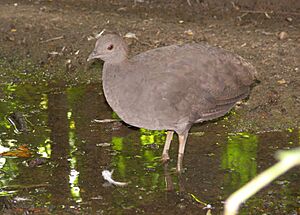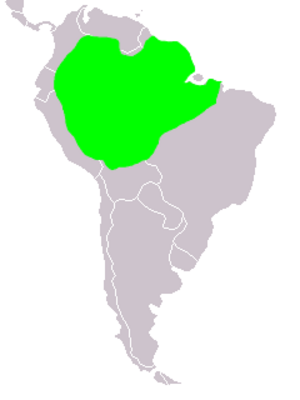Cinereous tinamou facts for kids
Quick facts for kids Cinereous tinamou |
|
|---|---|
 |
|
| Conservation status | |
| Scientific classification | |
| Genus: |
Crypturellus
|
| Species: |
cinereus
|
 |
|
| range map of the cinereous tinamou | |
The cinereous tinamou (Crypturellus cinereus) is a special kind of bird that lives on the ground. You can find it in swampy and low-lying forests in northern South America. People in different places have special names for it, like inambu-pixuna in Amazonas, Brazil. This bird has been around for a very long time. It's part of one of the oldest bird families in the world! Fossils show they existed millions of years ago. Their quick movements help them survive in the wild.
Contents
What is a Cinereous Tinamou?
The cinereous tinamou belongs to a bird family called Tinamidae. All tinamous are part of a larger group called ratites. Other ratites include ostriches and emus. Unlike most ratites, tinamous can fly, but they are not very strong fliers. Scientists believe tinamous are closely related to ancient flying birds.
How Did It Get Its Name?
The cinereous tinamou got its official name in 1789. A German naturalist named Johann Friedrich Gmelin first described it. Its scientific name is Crypturellus cinereus. The first part, Crypturellus, means "small hidden tail" in Ancient Greek. The second part, cinereus, is Latin for "ash-grey" or "ash-colored." This name fits because of its color! There are no different types or subspecies of this tinamou.
Appearance: What Does a Cinereous Tinamou Look Like?
The cinereous tinamou is a shy bird. It is about 29 to 32 centimeters (11 to 13 inches) long. Male birds weigh around 435 grams (15 ounces). Females are a bit heavier, weighing 549 to 602 grams (19 to 21 ounces).
Colors and Features
This bird is dark brown, almost black. It has a smoky-grey head with a reddish-brown top. Its color helps it blend in with its surroundings. This makes it harder for predators to spot them. The underside of the bird is slightly lighter. Its legs are a dull orange to yellow. They have a light ring around their eyes. Their beak is dark on top and yellow underneath. Females are usually a little bigger than males.
Distinctive Call: The Tinamou's Whistle
The cinereous tinamou is famous for its loud whistle. You can hear it mostly at dawn and dusk. This whistle has a unique sound and lasts almost two seconds. It is very hard to find the bird when it calls. This is because it can make its voice seem like it's coming from another direction. The calls of males and females are similar but not exactly the same. The time between calls gets shorter as they continue.
Where Do Cinereous Tinamous Live?
The cinereous tinamou stays in one area. It lives in southern Colombia, southern Venezuela, Suriname, Guyana, and French Guiana. You can also find it in northern and western Brazil, eastern Ecuador, eastern Peru, and northern Bolivia. In Brazil, it lives in the Amazon Basin.
Preferred Habitats
These birds live in lowland rainforests and swamp forests. They can be found up to 700 meters (2,300 feet) high. They also live in forests that are growing back. Sometimes, they use coffee and cocoa farms. They prefer to live near streams or in thick, dark swampy woods. Their favorite habitat is dense and dark.
Behavior: How Do Tinamous Act?
Cinereous tinamous are active during the day. When they get scared, they run away very fast. They have learned to react quickly to avoid predators. This is why humans rarely see them.
Movement and Flight
They usually walk or run instead of flying. They can fly, but their flights are short and direct. They tend to be alone or in pairs. They usually do not travel in large groups.
Breeding Habits
Cinereous tinamous can breed all year because of the warm climate. However, they prefer to mate from August to October. In Colombia, their preferred mating time is June. Male tinamous often mate with several females. Females may also mate with several males.
Courtship and Nests
To attract females, males will call out. The courtship dance involves the male lowering his chest to the ground. He stretches his neck forward and raises his back. This might make him look bigger and more attractive to females. It might also make him look more dangerous to other males.
The tinamou's "nest" is usually just a spot on the forest floor. It might have a few leaves. They choose a hidden place, often near a tree. The female lays about two eggs. These eggs are a beautiful salmon violet color. Over time, the eggs change to a dark or milk chocolate color.
Young Tinamous
Baby cinereous tinamous can move around almost as soon as they hatch. They are dark brown with reddish spots.
What Do Cinereous Tinamous Eat?
The food cinereous tinamous eat changes with the seasons. They mostly eat plants, especially fruit. This is similar to other birds in their family.
Seasonal Diet
In the summer, they eat small fruits, seeds, and tiny invertebrates. Most of the invertebrates they eat are ants, mole-crickets, and other bugs. In winter, they eat many different seeds or berries found on the ground. They especially like the acai berry.
Finding Food
Young tinamous eat more insects than adults. Cinereous tinamous do not scratch the ground for food. Instead, they look under leaves or use their beak to dig. They help nature by eating many insect pests.
Conservation Status: Are They Safe?
The IUCN (International Union for Conservation of Nature) says this tinamou is of Least Concern. This means it is not currently at high risk of disappearing. It lives across a very large area, about 5.9 million square kilometers (2.3 million square miles).
Threats to Their Home
It is the most common tinamou in Suriname. However, it is uncommon in Peru. The biggest threat to this bird is deforestation. This is when forests are cut down. Losing their home means fewer places for them to live. Scientists believe it loses 14% to 17% of its habitat over three generations.
Sources


